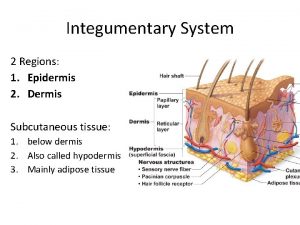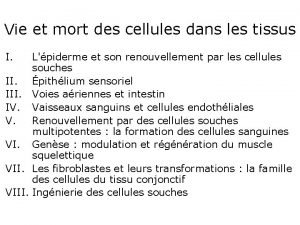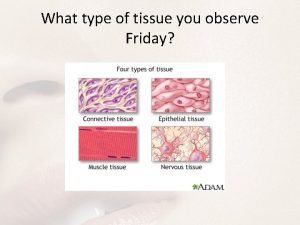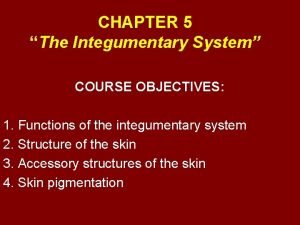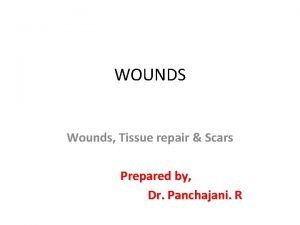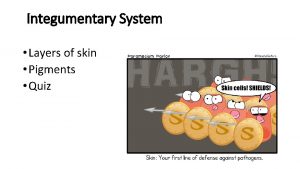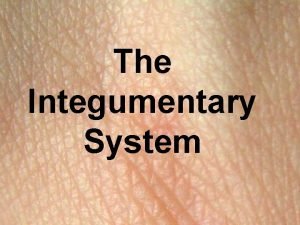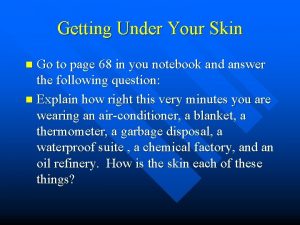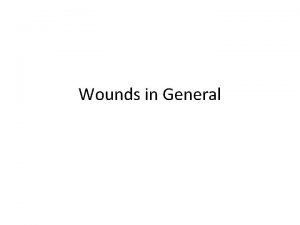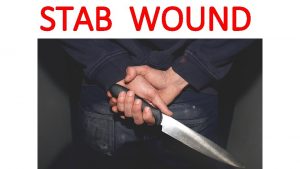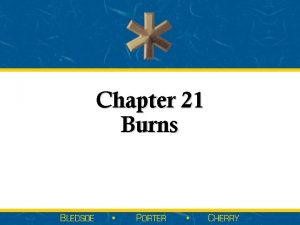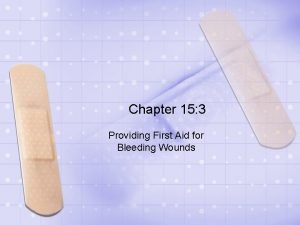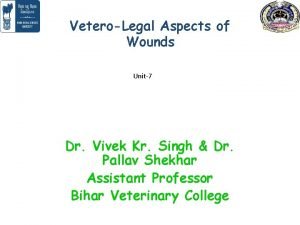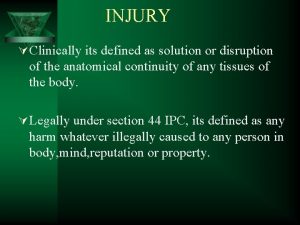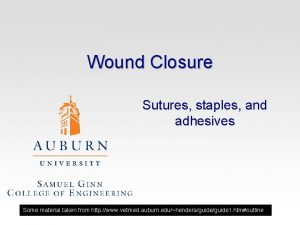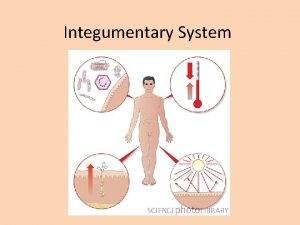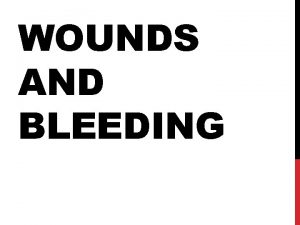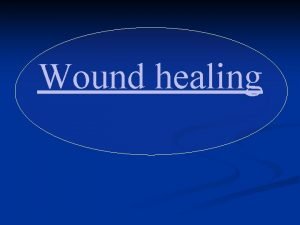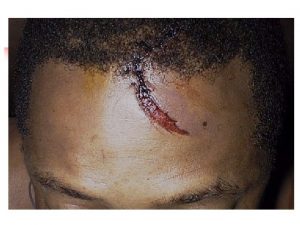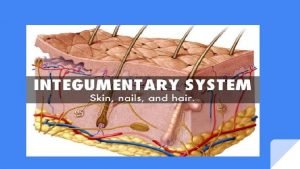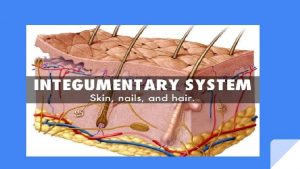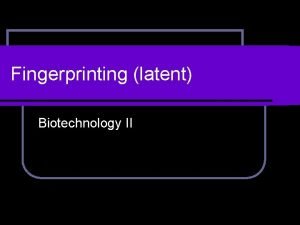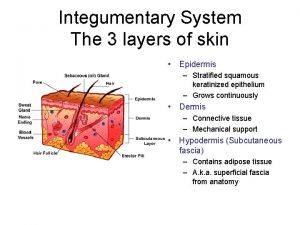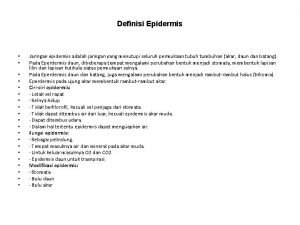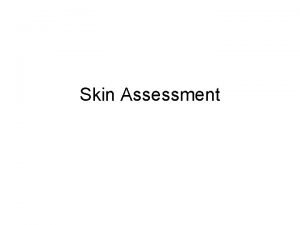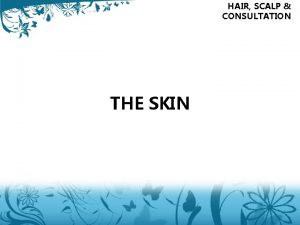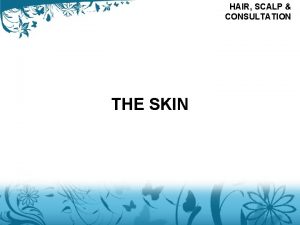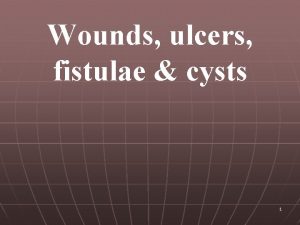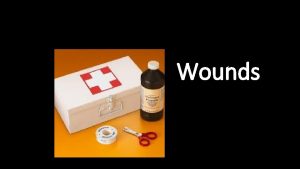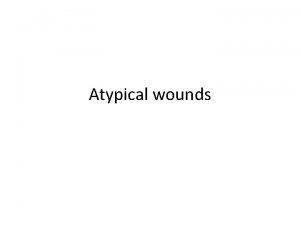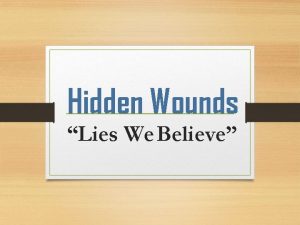Skin Wounds Classification Layers of the skin Epidermis





















- Slides: 21

Skin Wounds Classification

Layers of the skin: • Epidermis: most superficial layer –prevents the entry of foreign substances • Dermis: middle layer –contains blood vessels, hair follicles, sweat glands and nerves • Subcutaneous: deepest layer of skin – fatty tissue 2 –conserves body’s heat and protects from injury

Soft Tissue Injuries o. Trauma that happens to the skin is visually exposed o. Categorized as a skin wound: o. Abrasion o. Laceration o. Avulsion o. Puncture o. Contusion o. Blister

Abrasion o Skin scraped against a rough surface o Several layers of skin are torn loose or totally removed o Usually more painful than a deeper cut b/c scraping of skin exposes millions of nerve endings

Abrasion—Treatment o. Control the bleeding o. Wash wound to remove all dirt and debris o. Soap and water or hydrogen peroxide o. Scrub wound if anything is embedded o. Leave open to air, unless oozing of fluid or blood o. Apply antibiotic ointment to inhibit infections o. Keep clean

Abrasion—Treatment o. Loose skin flaps my form natural dressing; if flap is dirty then remove o. Watch for signs of infection o. Seek medical attention if any of following: o. Pain increases after several days o. Redness/red streaks appear beyond edges of wound o. Persistent drainage

Laceration(shallow)

Laceration(deep)

Laceration • Flesh irregularly torn or cut in the skin • Minimal bleeding, minimal pain, & no numbness or tingling • Cuts less than 1/4” deep and have smooth edges can be treated at home (steri strips) • Deeper lacerations should be treated by physician (stitches)

Laceration—Treatment o. Control the bleeding o. Clean with soap and water o. Irrigate with clean water to remove debris o. Do NOT use alcohol, iodine, or peroxide as it may cause further damage and slow healing process o. Cover wound with antibiotic and sterile gauze

Laceration—Treatment o Once wound cleaned, antibiotic ointment may be applied to reduce risk of infection & aid healing o Bruising and swelling are normal o Apply ice to site o Contact a physician if: o Laceration is deeper than 1/4” deep o The wound is in area where wound by be opened by simple movement of body part o Loss of sensation or ROM of body part as result of cut

Laceration—Treatment

Avulsion o. Layers of skin torn off completely or only flap of skin remains o. Same mechanism as laceration, but to extent that tissue is completely ripped from it’s source o. May be considerable bleeding

Avulsion—Treatment o Control the bleeding o Clean wound with soap and water o If flap of skin remains connected replace skin in its original position o If deep avulsion, seek medical attention for stitches o if skin flap is dirty, remove

Puncture Wound o. Penetration of skin by sharp object o. Nails, tacks, knives, teeth, spikes, cleats o. May be small in diameter and not seem serious o. Does require treatment by physician o. Can become infected easily b/c dirt and germs carried deep in the tissue

Puncture wound treatment wound. Wound. Treatment o Find out if part of object that caused wound still in the wound oi. e. lead from a pencil o Determine if other tissues have been injured by the object o. Blood vessels, nerves, tendons, ligaments, bones, internal organs o Prevent infections o. Bacterial skin infections, tetanus, infections in deeper structures (bones and joints)

Contusion o. A blow compresses or crushes the skin surface and produces bleeding under the skin o. Does not break skin o. Bruising due to injury to blood vessels o. Most mild and respond well to RICE

Contusion—Signs & Symptoms o Bruising (Ecchymosis) o swelling (Edema) o Pain to touch o Redness

Contusion—Treatment o. Careful monitoring o. Anti-inflammatory oral medications o. Rest o. Ice o. Compressive dressing o. Elevation (above heart)

Blister o. Continuous rubbing over the surface of the skin causes a collection of fluid below or within the epidermal layer

Blister—Treatment o Wash area thoroughly o Use sterile blade to cut small hole in blister o Squeeze out clear fluid o Do not remove skin o Prevention: o Wear work gloves o Break in new shoes o Petroleum jelly/skin lube o Adhesive bandage
 #1
#1 Epidermis layers
Epidermis layers The integumentary system facts
The integumentary system facts Epidermis of thick skin
Epidermis of thick skin Duct of merocrine sweat gland
Duct of merocrine sweat gland Thick vs thin skin
Thick vs thin skin Types of wound classification
Types of wound classification Meissner’s corpuscles
Meissner’s corpuscles Stratum granulosum
Stratum granulosum Star-shaped macrophages that patrol deep epidermis
Star-shaped macrophages that patrol deep epidermis 7 layers of skin
7 layers of skin Layers of skin from outermost to innermost
Layers of skin from outermost to innermost Layers of skin from outermost to innermost
Layers of skin from outermost to innermost Kinds of wounds with pictures
Kinds of wounds with pictures Unit 15:7 providing first aid for heat exposure
Unit 15:7 providing first aid for heat exposure Concealed puncture wound
Concealed puncture wound Jackson's theory of thermal burns
Jackson's theory of thermal burns Chapter 16:3 providing first aid for bleeding and wounds
Chapter 16:3 providing first aid for bleeding and wounds Veterolegal meaning
Veterolegal meaning Bevelling cut wound
Bevelling cut wound Hunting group of companions archetype
Hunting group of companions archetype Staple gun for wounds
Staple gun for wounds
